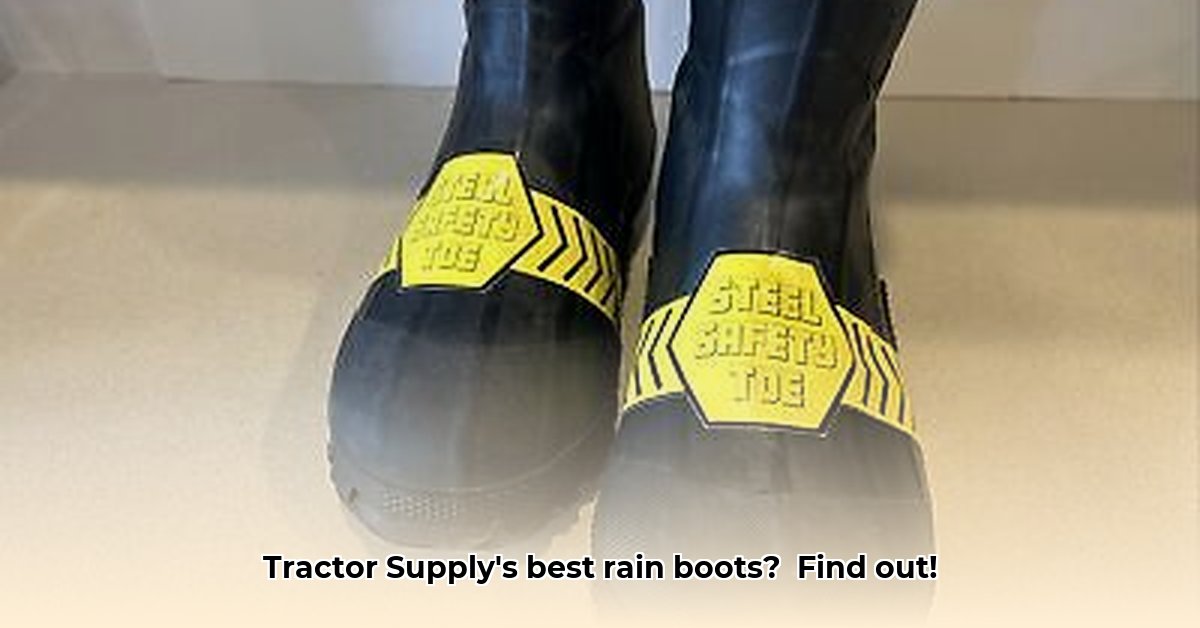
Rain Boots and Sustainable Agriculture: A Necessary Partnership
Finding the right rain boots is more than just a matter of comfort; it's a crucial aspect of sustainable agricultural practices. Protecting farmworkers from the elements is paramount for both safety and productivity. However, the environmental impact of traditional rain boot production and disposal is significant. This guide will help you navigate the options available at Tractor Supply, focusing on sustainable choices that benefit both the wearer and the planet. We'll explore the environmental impact of conventional boots, delve into sustainable alternatives, and provide a practical buying guide to help you make an informed decision. For more women's options, check out Tractor Supply Boots.
The Environmental Footprint of Traditional Rain Boots
Many conventional rain boots are manufactured using synthetic rubber or PVC (polyvinyl chloride). The production of synthetic rubber often relies on energy-intensive processes and can involve the use of harmful chemicals. PVC, a type of plastic, is notoriously difficult to recycle and persists in landfills for decades, contributing significantly to pollution. Moreover, the often-substandard construction of many budget rain boots means frequent replacement, leading to increased waste. But the environmental impact doesn't stop with production; the disposal of these boots adds further strain on our ecosystems. What's the environmental cost of those seemingly simple rain boots? It's far higher than many realize.
Sustainable Rain Boot Alternatives: A Greener Step
Fortunately, a growing number of environmentally conscious alternatives are available. Rain boots made from recycled rubber offer a significant improvement. These boots repurpose existing materials, drastically reducing the demand for new resources and minimizing waste. Another emerging category is bio-based materials derived from renewable sources such as plants. These offer the potential for a lower carbon footprint and biodegradability, although their overall durability and waterproofing effectiveness are still under scrutiny and vary significantly between products. Choosing recycled rubber or bio-based options is a clear step toward a more sustainable agricultural practice.
A Buyer's Guide to Sustainable Rain Boots
Selecting sustainable rain boots requires careful consideration of several key factors. This isn't just about finding a stylish boot; it's about making a long-term investment in your comfort and the planet's health.
Material Composition: Prioritize boots made with a high percentage of recycled rubber (look for at least 50% recycled content). Check for certifications like Global Recycled Standard (GRS) or OEKO-TEX Standard 100, which indicate responsible manufacturing practices and reduced chemical usage. Bio-based materials are promising, but always thoroughly investigate the manufacturer's claims regarding their sustainability and durability. Avoid PVC altogether.
Durability and Construction: Farm work demands sturdy footwear. Look for reinforced seams, durable stitching, and a robust sole designed to withstand rugged conditions. Investing in higher-quality, longer-lasting boots is more sustainable than repeatedly replacing cheaper, less durable options.
Essential Waterproofing: Keeping your feet dry is crucial for comfort and safety. Ensure the boots are adequately waterproofed, preferably with a tested and proven waterproof membrane or coating. Read reviews carefully to gauge the actual waterproof performance under real-world conditions. Don't simply rely on marketing claims alone.
Sole and Traction: The sole is your connection to the ground. A well-designed sole with a robust tread provides essential grip and stability on muddy or slippery surfaces. Consider the specific terrain you'll encounter to ensure optimal traction.
Fit and Comfort: Comfort is paramount. Ill-fitting boots can lead to discomfort, blisters, and even injuries. Pay close attention to the sizing information and try boots on, if possible, to ensure a proper and comfortable fit.
Comparing Sustainable Rain Boot Options: A Practical Overview
| Material | Environmental Impact | Durability | Cost | Comfort | Availability at Tractor Supply (Example) |
|---|---|---|---|---|---|
| Recycled Rubber | Low | High | Moderate | Varies | Check individual product listings |
| Bio-based Materials | Potentially Low | Moderate to High | High | Varies | Check individual product listings |
| Conventional Rubber | Moderate | Moderate | Low | Varies | Likely widely available |
| PVC | High | Low | Low | Often poor | Likely widely available, but should be avoided |
Note: The availability and specific characteristics of these materials can vary depending on the manufacturer and specific product. Always check product descriptions and customer reviews before making a purchase.
Maintaining and Extending the Life of Your Rain Boots
Proper care significantly extends a rain boot's lifespan, maximizing its environmental value.
- Regular Cleaning: Remove mud and debris after each use. A gentle scrub with water and a soft brush is usually sufficient.
- Appropriate Storage: Store your boots in a cool, dry place away from direct sunlight to prevent mold and mildew growth.
- Prompt Repairs: Addressing minor damage promptly prevents further deterioration and extends the boots' usable life.
- Responsible Disposal: When your boots reach the end of their life, explore recycling options (if available) or dispose of them according to local waste management regulations.
Actionable Steps for a More Sustainable Future
Addressing the environmental impact of rain boots requires a collaborative effort from various stakeholders.
For Consumers: Prioritize purchasing rain boots made of recycled or bio-based materials. Demand more transparency and sustainable practices from manufacturers.
For Manufacturers: Increase the use of recycled and renewable materials. Improve product durability and design for easier recycling or repurposing. Implement more transparent labeling regarding material sourcing and environmental impact.
For Tractor Supply and Similar Retailers: Expand the selection of sustainable rain boots. Promote environmentally friendly options through clear labeling and in-store displays.
For Governments and Regulatory Bodies: Encourage sustainable innovation through grants and incentives for sustainable material development. Strengthen regulations regarding harmful chemicals in footwear production and implement stricter standards for responsible waste management.
Conclusion: Stepping Towards Sustainable Agriculture
Choosing sustainable rain boots is more than just a purchase decision; it's a commitment to responsible farming practices. By making informed choices and demanding greater transparency and sustainability from manufacturers and retailers, we can collectively reduce the environmental footprint of agricultural footwear and create a more equitable and sustainable future for farmworkers and the planet.